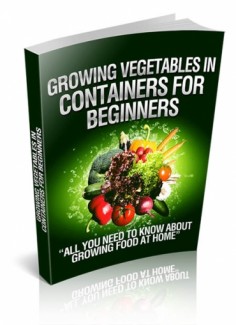 License Type: Resell Rights
License Type: Resell Rights  File Size: 1,552 KB
File Size: 1,552 KB File Type: ZIP
File Type: ZIP
 SKU: 51676
SKU: 51676  Shipping: Online Download
Shipping: Online Download
Ebook Sample Content Preview:
How Do I Water A Container Garden?
Watering a container garden is vital if you want your plants to survive, so it is important that you think about access to your containers and how far they are from your water source. If they are too far then carrying the water becomes a burden and you may end up finding excuses not to water your plants.
Your plants will need watering whenever they become dry and you can check this by pushing your finger in to the soil up to the second knuckle. If it feels dry at your finger tip then it needs watering. If it feels wet then do not water it.
Do not think that just because it rains your containers do not need watering. Because there is a limited soil area in a container and much of this is covered by plants you will be surprised how little rain actually gets in to a container! This means that even in the rain you will need to go out and water your containers.
Plants prefer watering in the morning which is when they are sucking up water to prepare for their growth during the day. However, if this is not possible then feel free to water them in the evening as they will not complain too much.
Just be very careful that you water at the roots of the plant, directly on to the soil rather than on the leaves. This prevents the water from running off the plants and completely missing the roots of your plants. It will also prevent many of the diseases and problems that plants have.
If you water the leaves in the morning then the water droplets on the leaves can act like magnifying glasses and magnify the rays of the sun so that the leaves get burnt and damaged. If you water them in the evening then you risk introducing mildew or other fungal diseases because the leaves do not get chance to dry out well enough.
You will want to water your plants daily during the growing season if they need it and whilst you do, check the plants for any pests or diseases too.
What About Fertilizing My Containers?
If you have used the soil mix that was mentioned earlier in this report then you will not need to fertilize your containers at all in the first year. If you have not then you are likely to have to start fertilizing them when the fruit appears.
A liquid feed is best as it easy to apply and goes straight to the roots where it is needed. You can get specific feeds for specific plants, i.e. a tomato food. It is best to use this where you can as it gives the plants the exact balance of nutrients that they need to promote healthy growth. If you use a fertilizer high in nitrogen with tomato plants then they will concentrate on producing leaves and not fruit. Therefore you need to use the right type of food for your plants.
Follow the directions on the fertilizer for how to best use it with your vegetable plants. You will want to feed them once every week or two, depending on how greedy the plants are. A pumpkin will need a lot more food than something like a radish or beet.
How Can I Minimize The Risk Of Pests?
Pests are a big problem for any gardener and hopefully you will avoid many of the problems that come from growing directly in soil. When you water your plants, give them a quick visual inspection and check for pests and other problems.
You may encounter aphids, which gather on the tender tips of your plants and the new growth. If you catch these early enough then you can pick them off by hand and crush them between your fingers. If they have taken hold then you are probably going to have to use a spray to get rid of them. Use organic if you can as this is going to be much better for the environment. Always check the label though and make sure that the spray is suitable for edible crops. If it does not explicitly state this then avoid the spray as it could introduce potential toxins in to your vegetables and so in to your body.
Slugs and snails are other problematical pests that you are likely to encounter and these can be tricky to get rid of. There are lots of gimmicks that supposedly deter them but sadly none of them are particularly effective. Your best bet is to go out at dusk and pick them off your plants by hand and destroy them. Do not think that throwing them over the wall will deter them; they will be back! Therefore you have to destroy them to stop them destroying your crop. During the day time, check around your pots for their slimy trails; you may find them hiding underneath or behind your pots during the day!
There are other pests that can affect particular plants though just look out for any problems, holes, discoloration and the like on your vegetables. If you do spot anything then look in to it carefully and see what is causing it. It is better to take action sooner rather than later as you are more likely to be able to save your crop.
What About Diseases In Container Gardens?
Diseases tend to be less of a problem in containers because you are using a clean soil. Many of the common plant diseases are found in the soil and by not growing in the ground you can avoid these problems.
Some diseases are air born and you can find diseases such as potato or tomato blight affecting your plants where it has blown in. This can be noticed by the leaves and stems starting to turn brown and curl up. If you notice the blight then you need to treat it immediately in order to prevent it from taking hold and killing your plants. If it is late enough in the season then you can cut the foliage off potatoes and the potatoes themselves will be okay under the ground. You can remove fruit from tomato plants and ripen it on a windowsill though the fruit can still be affected.








